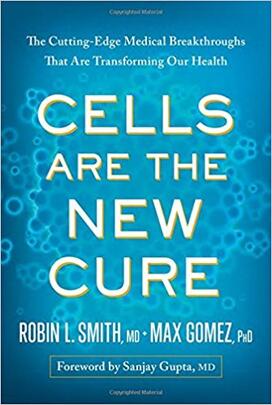An Exploration of the Potential of Stem Cells

The book: Promising stem cell treatments are being tested in thousands of clinical trials throughout the United States. These treatments use adult stem cells found in people’s own bodies to help eliminate cancer, for organ replacement, and to use the immune system to fight autoimmune diseases like multiple sclerosis, rheumatoid arthritis, and type 1 diabetes.
Cells are the New Cure: The Cutting-Edge Breakthroughs That are Transforming our Health (BenBella Books) explains in layman’s terms the exciting scientific developments in stem cell research that will soon be available to the public as a whole, allowing us to live longer and healthier lives, and which may even be able to slow or reverse the aging process itself.

Dr. Robin L. Smith is a global thought leader in regenerative medicine. While she was CEO of the NeoStem family of companies, she pioneered the company’s innovative business model, which combined contract development, manufacturing, and proprietary cell therapy development.
Opening lines: “Imagine a world where victims of irreversible spinal cord injuries are able to get out of their hospital beds and walk. Where there’s no shortage of donor organs for transplants — because we no longer need donors — we just grow new organs in laboratories. Where stem cells from bone marrow or fat are used to repair damaged hearts and spinal discs and lungs…In short, imagine a world of longer and healthier lives. This is the promise of cell therapies. What once seemed like science fiction, pipe dreams, or outright miracles is already becoming reality.”












2 Responses
Michael Otten ’63
8 Years AgoI thought the Trump...
I thought the Trump administration was dedicated to reduced regulation?
A. Rahman Ford
8 Years AgoWe cannot underestimate the...
We cannot underestimate the curative power of stem cell therapies. The FDA is poised to release new rules on the use of stem cell therapies. Although the FDA refers to its prospective actions as “enforcement” and “protection,” the likely impact is obvious and unsettling – safe and effective therapies that have been healing patients for years will become less available and more expensive.
It would seem that the FDA’s proposed effort to define and “police” the cellular therapeutic terrain is, in practice, a multifarious effort to: (1) retard medical innovation and force Americans to travel abroad for life-saving therapies; (2) trespass upon Americans’ constitutionally protected privacy right in their own bodies and narrow the
scope of application of autologous stem cell therapies that currently need no FDA approval; and (3) preserve a “clinical trial” drug-approval paradigm that, when applied to regenerative medicine modalities, has proven itself to be unduly burdensome, unreasonably slow and unbearably anachronistic.
When Congress passed and President Obama signed the 21st Century Cures Act, they made it clear the course this country was to take with regard to the modernization of medicine; regenerative medicine is an integral part of the future and federal policy should be crafted so that these therapies are more available and more affordable. President Trump affirmed that commitment when during his first congressional address – on Rare Disease Day – he told the story of Megan Crowley, an attendee who had used her own stem cells to successfully treat Pompe’s Disease.
More recently, states like Texas have passed legislation making life-saving stem cell therapies more
widely available to their residents. Both Congress and President Trump also support "right to try" legislation, making stem cell therapies less onerous for patients to procure. I have had stem cell therapy, so I know what it can do.
I went to China for my stem cells. I should not have to do that the next time. No American should.